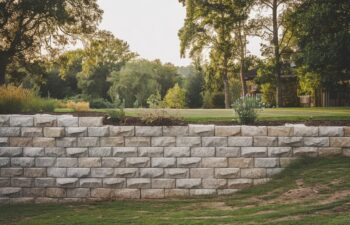
The Disappearing Yard Mystery
One day, your backyard looks perfect—green, lush, and exactly the way you want it. A few weeks later, you start noticing patches of bare dirt, puddles after rain, and exposed roots that weren’t there before. Fast forward a few months, and your beautiful lawn is looking more like a disaster zone. Sound familiar?
So, what’s happening? The answer is simple: soil erosion. But don’t worry—there’s a solution, and it comes in the form of something you’ve probably seen but never given much thought to: retaining walls.
As a wildlife removal expert, I see the damage erosion causes all the time, often worsened by burrowing animals like groundhogs and moles. But the good news is that homeowners can take action before the problem gets out of control.
Why Is Your Yard Disappearing?
Soil erosion is one of those sneaky problems that starts slow and then suddenly becomes impossible to ignore. You might not notice it at first, but over time, the landscape around your home begins to shift—literally.
Common Signs of Soil Erosion
- Deep grooves or channels in the soil where water has been running off
- Exposed tree and plant roots
- Patches of dirt replacing grass, especially on slopes
- Sinking or shifting ground near foundations, driveways, or patios
- Puddles or standing water after rainstorms
What Causes Soil Erosion?
- Water Runoff: Heavy rains can wash away topsoil, leaving your yard looking patchy and uneven.
- Wind: If you live in an area prone to strong winds, dry soil can be blown away over time.
- Foot Traffic: Kids, pets, and even routine lawn maintenance can contribute to soil compaction and erosion.
- Burrowing Animals: Groundhogs, moles, and rabbits dig tunnels that loosen soil, accelerating erosion.
Retaining Walls: Your Secret Weapon Against Erosion
A well-built retaining wall can be the difference between a stable, thriving yard and a muddy, unstable mess. Retaining walls act as barriers, holding soil in place and preventing it from washing away.
How Retaining Walls Work
- Soil Retention: Walls keep soil where it belongs, especially on sloped areas.
- Improved Drainage: They help control water flow, preventing pooling and minimizing damage.
- Enhanced Aesthetics: Beyond function, they add structure and beauty to your yard.
- Wildlife Deterrence: They can help prevent burrowing animals from undermining your yard’s stability.
I once had a client who couldn’t figure out why his backyard was caving in. He’d fix one area, only to find new sinkholes popping up elsewhere. Turns out, a family of groundhogs had set up camp under his property, tunneling through and destabilizing the soil. After evicting the furry squatters, we installed a retaining wall—and the yard hasn’t moved an inch since.
Choosing the Right Retaining Wall for Your Yard
Not all retaining walls are created equal. The right choice depends on your budget, soil type, and aesthetic preferences.
Material Options
- Natural Stone: Elegant and durable, but pricier.
- Concrete Blocks: Affordable and strong, perfect for DIY projects.
- Timber: Budget-friendly but requires maintenance to prevent rot.
- Brick: Classic and sturdy, but more labor-intensive to install.
More Ways to Prevent Soil Erosion
While retaining walls are a fantastic solution, they work even better when combined with other erosion control methods.
1. Smart Landscaping
Planting deep-rooted plants and native ground covers can help hold soil in place. Consider:
- Native grasses
- Shrubs with strong root systems
- Mulch to protect soil from erosion
2. Improve Drainage
- Install French drains to redirect water flow.
- Use permeable pavers instead of solid concrete to allow better water absorption.
- Create rain gardens in low areas to capture excess water.
3. Keep Wildlife in Check
As a wildlife removal expert, I can’t stress this enough: burrowing animals will turn erosion into a full-blown crisis. If you notice holes or tunnels, consider humane deterrents like:
- Fencing around vulnerable areas
- Natural deterrents (e.g., predator scents, noise devices)
- Professional removal if necessary
Take Action Before It’s Too Late
Erosion won’t fix itself, and the longer you wait, the worse it gets. Retaining walls are a tried-and-true method for stopping soil loss, protecting your home, and enhancing your yard.
If you’ve noticed signs of erosion or suspect burrowing wildlife is making matters worse, don’t wait until you have a full-blown landscape disaster. Start exploring your retaining wall options today—your yard (and your wallet) will thank you!
Need advice on erosion control or dealing with burrowing pests? Feel free to reach out—I’ve seen it all and am happy to help!







